
MEMBER ACCOUNT
EMPEROR'S HAMMER
TIE CORPS
OPERATIONS
- Battle Center
- Patch Archive
- Competition Center
- Combat Center
- Imperial University
- Mission Creation Center
- Fiction Center
DATA CENTER
- Killboards
- Squadron Battleboards
- Pilot Statistics and Ranks
- Medal Board
- Uniforms
- Roster Tools
- Complete Craft List
COMMUNICATIONS
EH SUBGROUPS
REFERENCE & MANUALS
- Encyclopaedia Imperia Wiki
- TIE Corps Pilot Manual
- SO Dark Side Compendium
- COO Manual
- Tactical Manual
- Fleet Manual
- Training Manual
- System Manual
- Fleet Order of Battle
EH POLICIES & INFO
UTC
Cold Assault Stormtrooper Course Notes
Introduction
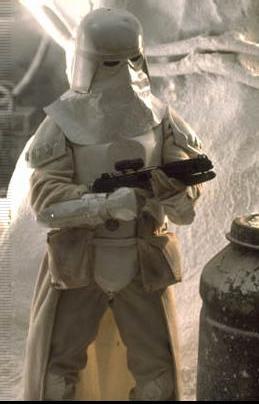
Snowtroopers, or “Blizzard Force stormtroopers” are the elite arctic combat unit of the Hammer’s fist. They are specialized cold-assault stormtroopers trained to fight in frozen environments, such as the desolate wastelands of Hoth. Blizzard Force troopers are trained to work in tandem with AT-AT walkers, although they can travel long distances on foot. There is no stealth involved in Blizzard Force tactics. They are trained to hit a planet fast and hard -- like a blizzard -- crushing any opposition quickly and completely. Once walkers secure an area, snowtroopers disembark via zip-lines and then go about clearing any pockets of resistance.
Snowtroopers were largely responsible for routing the Rebel infantry during the Battle of Hoth.
Equipment
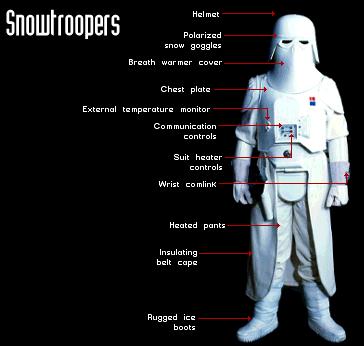
Snowtroopers have proven one of the most successful specialized stormtrooper units, largely due to their advanced suits. The Blizzard Force stormtroopers wear the typical black, two-piece temperature control body glove worn by other stormtroopers. Over this is an 18-piece outer shell that has been altered to include more powerful heating and personal environment units, and an airtight fabric oversuit for additional protection from the cold. To facilitate breathing in extremely cold or dangerous atmospheres, a breather hood envelops the snowtrooper's faceplate and feeds into the suit liner. In addition, snowtroopers wear terrain-gripping boots to combat slippery conditions. Polarized snow goggles, a wrist comlink, and an insulating cape complete the outfit. The entire suit is powered by a heavy-duty power cell located on the snowtrooper’s backpack. Snowtroopers can survive for up to two weeks in even the harshest frozen environments on this power supply alone.
Each trooper is equipped with a standard utility belt containing hightension wire, grappling hooks, ion flares, additional blaster ammo, a survival kit, and food and water packs.
Snowtroopers carry blaster pistols, blaster rifles, and two concussion grenades. Standard armament of the snowtrooper is the BlasTech E-11 stormtrooper rifle. Specialized teams use E-Web heavy repeating blasters mounted on tripods to provide support.
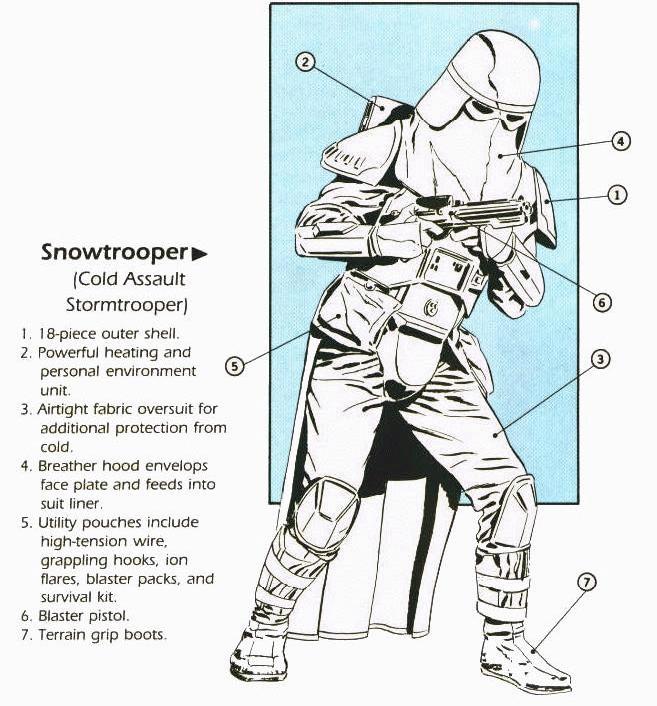
Cold Weather Considerations
The arctic environment is a dynamic force. He who recognizes and understands this force can use it; he who disregards or underestimates this force is threatened with failure or destruction. Because of the demanding requirements on the individual snowtrooper, leadership must be of the highest caliber. Leaders at all levels down to the squad, must make decisions far surpassing the scope of their usual responsibilities. In the arctic, the human element is all-important. The effectiveness of equipment is greatly reduced. Specialized training and experience are essential. The climate does not allow a margin of error for the individual or the organization. The ground mobility of all units is restricted. Movements must be carefully planned and executed with the knowledge that distance can be as difficult to overcome as the enemy.
Momentum is difficult to achieve and quickly lost. All available means of transportation must be considered and used to maximum advantage. The use of AT-AT walkers provides both rapid mobility for the snowtrooper squads and heavy fire support.
Because of the stresses imposed by the arctic environment, maintenance of equipment is difficult and of great importance.
Weather Phenomena
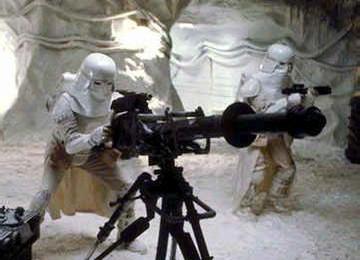
Whiteout. A milky atmospheric phenomena in which the observer appears to be engulfed in a uniformly white glow. Neither shadows, horizon, nor clouds are discernible. Sense of depth and orientation is lost. Only very dark nearby objects can be seen. Whiteouts occur over an unbroken snow cover and beneath a uniformly overcast sky. With the aid of the snow blink effect, the light from the sky is about equal to that of the snow surface. Blowing snow can cause the same effect. The whiteout phenomena are experienced in the air as well as on the ground.
Greyout. Greyout is a phenomenon which occurs over a snow covered surface during twilight conditions or when the sun is close to the horizon. There is an overall greyness to the surroundings, and when the sky is overcast with dense cloud there is an absence of shadows, resulting in a loss of depth perception which increases the hazard in landing an aircraft, driving a vehicle along a road, skiing or even when walking, with the effect greatest when a person is fatigued. The phenomenon is similar to whiteout except that the horizon is distinguishable under greyout conditions and not distinguishable during a whiteout.
Ice Fog. The phenomenon of ice-particle fogs is a very common occurrence around inhabited areas during cold winter weather. They are found most of the time when temperatures drop below -35 ° F. Their origin, in marked contrast to that of ordinary super-cooled fogs, lies in the copious local production of water vapor by human activities, coupled with an inability of the stagnant air at such low temperature to hold the water vapor. Such sources of water vapor may include the ice melting from AT-AT walkers and E-Web cannons, vapor from snowtrooper breather hoods and snow speeder exhaust, and the air ventilated from humid. In the field, such a fog may appear over a body of troops, bivouac areas, speeder parks, convoys, and gun positions when firing. Ice fog obscures the gunner's vision along the line of fire and may disclose the location of weapons, vehicles, and troops. During darkness ice fog limits or negates the effectiveness of night vision devices.
Mobility
Snow affects mobility of ground troops in a number of ways. Heavy snow cover impedes movement, either cross-country or on roads. Snow cover also blankets many terrain features, hiding obstacles to movement suc h as brush, stumps, rocks, ditches, small streams, fallen trees, mine fields, and other manmade obstacles. Snow cover acts as a thermal insulator which retards the freezing or thawing of underlying ground. When snow melts, it saturates the ground and often makes it impassable. Traction on compacted snow is generally better during extreme cold weather.
Effects on Weaponry
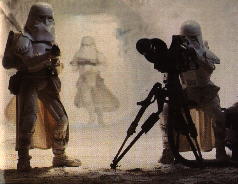
In extreme cold, metal becomes brittle. Increased parts breakage occurs in all types of weapons. Many weapons create ice fog which, on a still day, may obscure the gunner's vision; thus requiring movement to alternate positions or the use of a flank observer to direct the fire.
Trooper weapons will function under northern conditions when men have been trained in their proper maintenance and use. The main problem is to keep snow and ice out of the working parts, barrels, and sights. Special breech and muzzle covers should be provided and troops trained in their use.
As a result of bringing a weapon into a warm shelter, condensation or the melting of accumulated snow may occur which will cause it to freeze and malfunction when taken back into the outside cold temperatures. This condition can be prevented by leaving the weapons outside, under guard, or thoroughly cleaning them inside the shelter.
Cold Weather Tactical Factors
The following special factors will influence planning for snowtrooper operations:
Weather. Weather is an important factor to be considered in the estimate of the situation and may dictate a course of action. As an example, the attacker or defender in a snow storm with the wind at his back has a marked advantage.
Snow Cover. Snow enhances the movement of snowtroopers suitably equipped and trained, but reduces the mobility of Rebel forces lacking proper equipment and training.
Delayed Personnel Responses. The extreme environmental problems encountered by personnel require that delay and time lag be considered in all planning.
Artic Training
The basic requirements for training in snowtrooper operations are the same in all seasons.
Toughness, resourcefulness, initiative, and ability to live and operate in the field are required of each individual. In most respects snowtroopers trained in arctic conditions are capable of conducting operations during any other season.
Winter training is a task requiring a well-coordinated program and a competent instructional and administrative staff. For units that have completed advanced unit training, a training period of 12 weeks is desirable. Training for snowtrooper operations falls into the following phases (for technical units, some adjustment may be necessary between the indoctrination and specialist training):
| Indoctrination training | 8 weeks |
| Specialist training | 2 weeks |
| Unit/combined arms training (over and above in doctrination training) | 2 weeks |